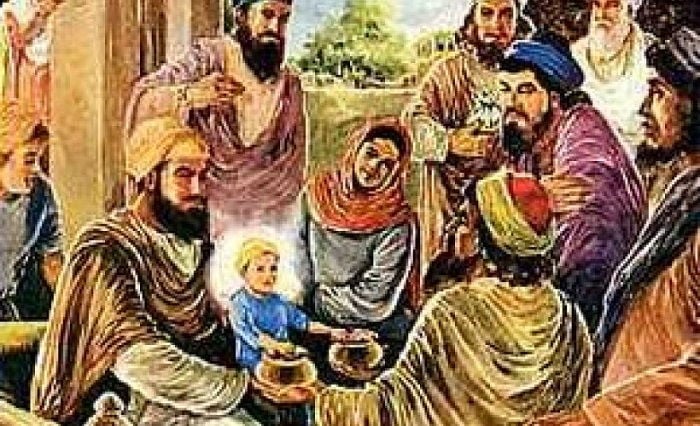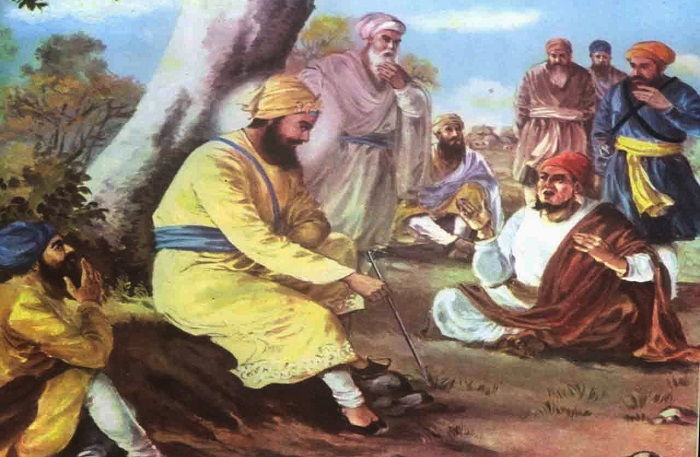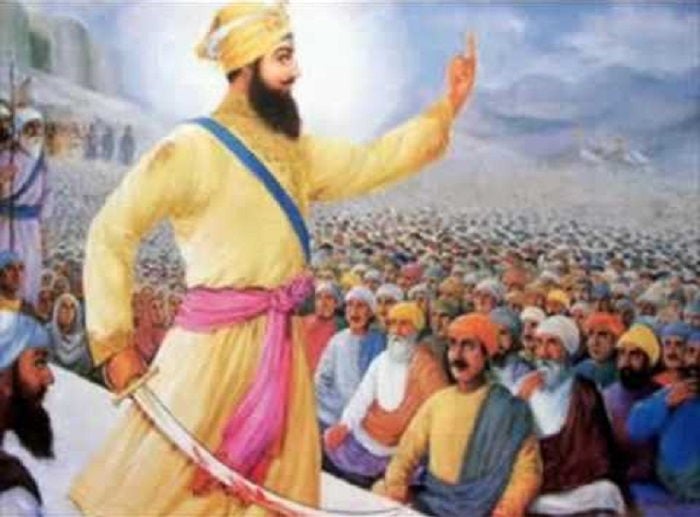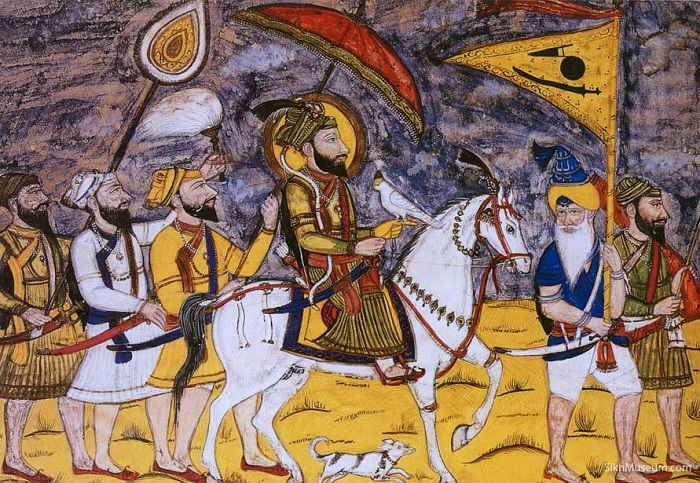Fast Facts
Date of Birth: January 5, 1666
Place of Birth: Patna Sahib, India
Death: October 7, 1708
Place of Death: Hazur Sahib, Nanded, India
Major Works: Introduced the Khalsa & the Five Ks; Declared Guru Granth Sahib as eternal Guru for Sikhs; Wrote Zafarnamah, Bachittar Natak, Chaupai (Sikhism), Akal Ustat, Jaap Sahib, Tav-Prasad Savaiye, Chandi di Var
Guru Gobind Singh was the tenth and last Sikh Guru, a spiritual leader, philosopher, poet and a great warrior. Born as Gobind Rāi, he emerged as tenth Sikh Guru at age nine after his father Guru Tegh Bahadur, the ninth Sikh Guru, was beheaded publicly by orders of Mughal emperor Aurangzeb as he refused to convert to Islam. Such atrocity led Guru Gobind Singh to found the Sikh warrior community called Khalsa that marked a significant event in the history of Sikhism. He also introduced the five articles famous as the Five Ks and commanded the Khalsa Sikhs to wear at all times. Other contributions of the Guru includes writing important texts on Sikhism and holding Guru Granth Sahib, the religious scripture of Sikhism, as the eternal living guru of the Sikhs.

Image Credit : https://www.sikhnet.com/news/birth-guru-gobind-singh-ji
Childhood & Early Life
He was born Gobind Rai on January 5, 1666 in Patna Sahib, Bihar, India in the Sodhi Khatri family of the ninth Sikh guru, Guru Tegh Bahadur and his wife Mata Gujri. The first Maharaja of Sikh Empire Ranjit Singh later built the Gurdwara Takht Sri Patna Sahib in the site of the house where Guru Gobind Singh was born and lived for the first four years of his life. The Guru returned to Punjab with his family in 1670 and later relocated with them to Chakk Nanaki on the edge of Shivalik Hills in March 1672 where he did his schooling.
In 1675, the Kashmiri Pandits approached Guru Tegh Bahadur to protect them from oppression of the Islamic satrap of Mughal Emperor Aurangzeb called Iftikar Khan. According to the composition Bachittar Natak written by Guru Gobind Singh, his father promised to protect the Kashmiri Pandits and was summoned to Delhi on a pretext by Aurangzeb and on his arrival, Tegh Bahadur was asked to convert to Islam. Tegh Bahadur was arrested along with his associates after he refused and was beheaded in public on November 11, 1675, in Chandni Chowk, Delhi. Such execution only toughened determination of the Sikhs to fight against atrocities of the Muslims in safeguarding their human rights and identity as Sikhs.
The martyrdom of his father led the Sikhs to formally install the nine year old Gobind Rai as the tenth Sikh Guru on March 29, 1676, on Vaisakhi. He continued with his education which apart from reading and writing also included archery, horse riding and other martial arts. Till 1685 he stayed in Paonta.

Image Credit : https://www.youtube.com/watch?v=sVlCHWyzuZI
Personal Life
The Guru had three wives. On June 21, 1677, he married Mata Jito at Basantgaṛh. Together they had three sons Jujhar Singh born on 1691, Zorawar Singh born on 1696 and Fateh Singh born on 1699. He married his second wife Mata Sundari on April 4, 1684 at Anandpur with whom he had a son called Ajit Singh born on 1687. His third wife was Mata Sahib Devan whom he married at Anandpur on April 15, 1700. They had no children. Mata Sahib Devan played an instrumental role in Sikhism and was proclaimed as Mother of the Khalsa by the Guru.
Introducing the Khalsa & the Five K’s Tradition
In 1699, the Guru asked the Sikhs to assemble at Anandpur on Vaisakhi. The Guru with a sword in hand called for a volunteer from among the crowd who is ready to sacrifice his head. On his third call one Sikh named Daya Ram (later called Bhai Daya Singh) came forward. The Guru took him in a tent and returned alone to the crowd with blood dripping from his sword. Another volunteer was called by the Guru who was again taken inside the tent and after some time the Guru returned alone with the bloody sword. He continued the process with three more volunteers but after the fifth volunteer went inside the tent, the Guru came out with all the five volunteers unharmed. The Guru blessed the five volunteers namely Bhai Daya Singh, Bhai Dharam Singh, Bhai Sahib Singh, Bhai Mohkam Singh and Bhai Himmat Singh and called them the Panj Pyare (the five beloved ones) and the first Khalsa in the Sikh tradition. The Guru then took an iron bowl and prepared a solution of water and sugar stirring it with a double-edged sword calling it Amrit (nectar). The five volunteers then received the nectar from the Guru amidst recitations from the Adi Granth. With this the khande ka pahul (baptization ceremony) of the warrior community of Khalsa was initiated. A new surname of “Singh” meaning lion was given to them by the Guru. The Guru then asked the five baptized Sikhs to baptize him as a Khalsa and with this the Guru became the sixth Khalsa and from this time he came to be known as Guru Gobind Singh.

Image Credit : http://thehistoryofsikhs.blogspot.com/2014/04/guru-gobind-singh-jis-life-images.html
The Guru commanded the Sikhs to wear five items all the time which included Kesh (uncut hair), Kangha (a comb made of wood), Kara (a bracelet made of iron), Kachera (a tieable undergarment made of 100% cotton) and Kirpan (a large iron dagger for self-defense). A code of discipline was introduced by him for the Khalsa warriors. These included prohibition of tobacco, eating ‘halal’ meat that is slaughtered as per Muslim ritual, fornication and adultery. The Khalsas consented never to communicate with followers of the rivals or their successors. The principle of equality was institutionalised in Sikhism with initiation of both men and women from different castes as Khalsas. The Guru played an instrumental role by institutionalising Khalsa in Sikhism thus strengthening the Sikhs in their resistance on the continuous persecution of the Mughal Empire under Aurangzeb. He came up with different concepts that posed indirect challenge to the biased tax system of the Islamic authorities.
The Sikhs had a system of Masands before the Khalsa was initiated. In this system the Masands were the representatives and tithe collectors in Sikhism who led the local Sikh communities and temples, and accepted donations and wealth for the Sikh cause. The Guru concluded that the Masands system had corrupted with time and abolished it while initiating a centralised system which would be directly supervised by him. The new developments however gave rise to disagreements within the Sikh community during the 18th century, especially between the Nanakpanthis and the Khalsas.

Image Credit : https://www.youtube.com/watch?v=x4hgtEpNXoE
Guru Granth Sahib & other Sikh Scriptures
Adi Granth, the first official edition of the Sikh scripture was compiled by the fifth Sikh Guru, Guru Arjan. It contained hymns of previous Gurus and of other saints. Adi Granth was eventually expanded into the Guru Granth Sahib. In 1706, Guru Gobind Singh released the second rendition of the religious scripture with addition of one salok, dohra mahala 9 ang, 1429 and all the 115 hymns of Guru Tegh Bahadur. The rendition came to be known as Sri Guru Granth Sahib. The Guru Granth Sahib composed by Guru Nanak Dev and other Sikh Gurus including Guru Arjan Dev, Guru Ram Das, Guru Angad Dev, Guru Amar Das, Guru Tegh Bahadur and Guru Gobind Singh and also containing traditions and teachings of Indian sants (saints), like Namdev and Kabir as also two Muslim Sufi saints Sheikh Farid and Bhagat Bhikan was declared as the eternal living guru for Sikhs by Guru Gobind Singh.
Many of the texts of the religious text Dasam Granth are traditionally attributed to Guru Gobind Singh. Considered an important religious scripture of the Sikhs after the Guru Granth Sahib, it includes compositions like Benti Chaupai, Tav-Prasad Savaiye and Jaap Sahib that form part of daily prayers (Nitnem) as also part of the baptism ceremony (Khande di Pahul or Amrit Sanchar).
The voluminous scripture Sarbloh Granth that encompass over 6,500 poetic stanzas also includes writings of the Guru.

Image Credit : https://commons.wikimedia.org/wiki/File:Guru_Gobind_Singh_with_followers.jpg
Sikh-Muslim Conflicts & the Zafarnama
Hostility between the Sikhs and the Muslims increased following execution of Guru Tegh Bahadur. Guru Gobind Singh believed in a Dharam Yudh that is to fight to defend righteousness and fought thirteen wars against the Mughal Empire and the kings of Siwalik Hills but never held captive or destroyed place of worship of other religions. Among the conflicts, the Second Battle of Anandpur (1704) witnessed a fierce battle and towards its end Aurangzeb offered a safe passage out of Anandpur for the Guru, his family and followers which the Guru accepted. However the two batches of the Sikhs were attacked while they were leaving Anandpur and the one including the Guru’s mother Mata Gujari and his two sons Zorawar Singh aged 8 and Fateh Singh aged 5 was captured. The two sons died after they were buried live into a wall when they refused to convert to Islam while Mata Gujri died hearing her grandsons’ death. The Guru lost two of his other sons Ajit Singh and Jujhar Singh, along with other Sikh soldiers during the Battle of Chamkaur (1704).
In 1705 following the Battle of Chamkaur where Aurangzeb and his army betrayed after making a promise the Guru wrote a defiant letter to Aurangzeb in Persian language titled Zafarnama (literally, “epistle of victory”). In the letter the Guru sternly censured and accused Aurangzeb and his commanders for being immoral, both in governing and in war conduct and predicted end of Mughal Empire in near future due to its immorality, persecution and untruthfulness.

Image Credit : https://www.sikhnet.com/news/guru-gobind-singh-ji%E2%80%99s-mission-connecting-dots
Last Years & Death
The Guru and his soldiers stayed at different places following the Second Battle of Anandpur in 1704 including hiding in the Machhiwara jungle of southern Panjab. Following a succession struggle after death of Aurangzeb in 1707, Bahadur Shah, the official successor wanted to meet the Guru in person in the Deccan area of India to reconcile with him. While the Guru camped at Nanded on the banks of Godavari River two Afghans, Jamshed Khan and Wasil Beg managed to enter his vicinity and Jamshed Khan stabbed the Guru. The Guru retaliated and killed Jamshed Khan while Wasil Beg was killed by the Sikh guards. The Guru succumbed to the wounds of the assault on October 7, 1708 which was followed by resurgence of the Sikh-Mughal war. While it is considered that Muslim army commander and the Nawab of Sarhandh Wazir Khan sent the assassins to kill the Guru, some scholars opine that they were sent by the Mughal army stationed nearby.
Maharaja Ranjit Singh built the Takht Sri Hazur Sahib in Nanded to commemorate the place of assassination of the Guru.


